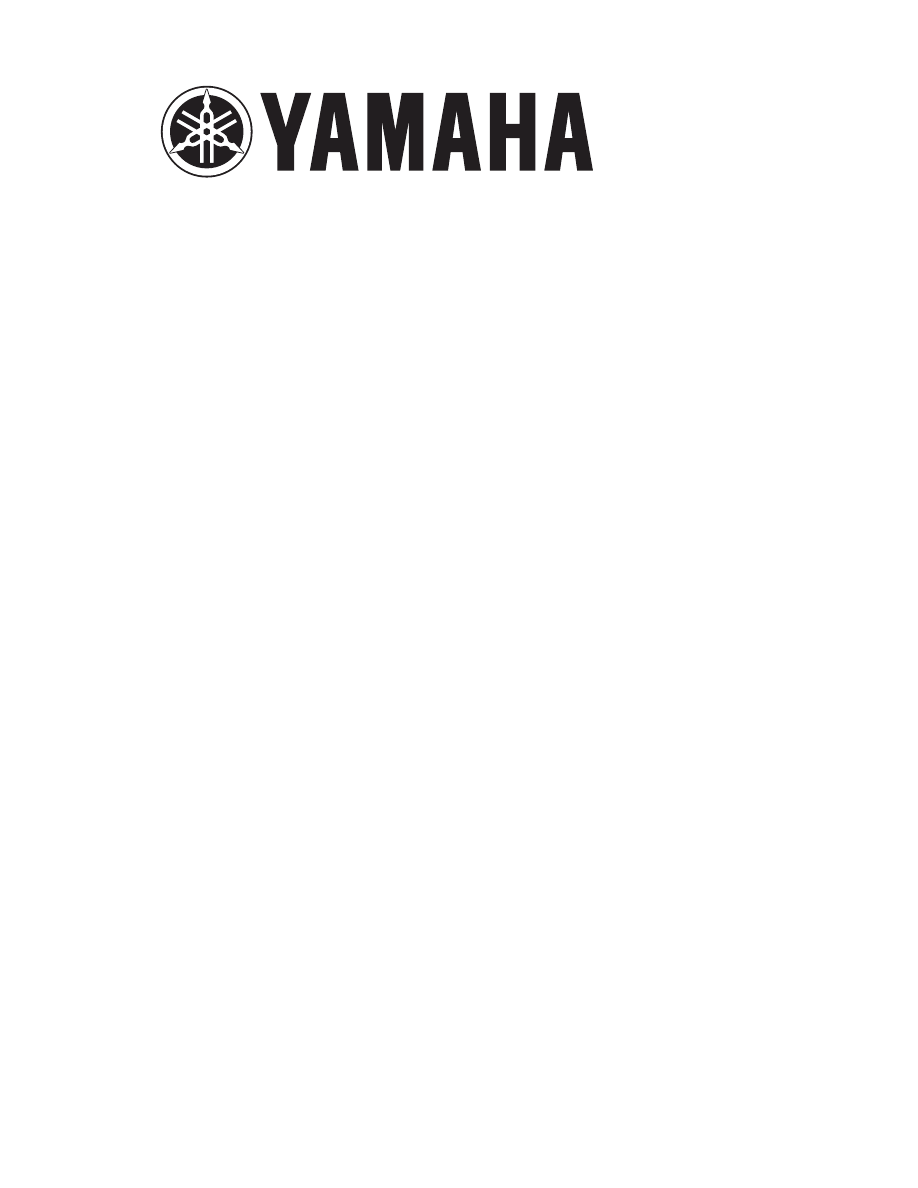
YFS200P
SUPPLEMENTARY
SERVICE MANUAL
LIT-11616-15-05
3JM-28197-11
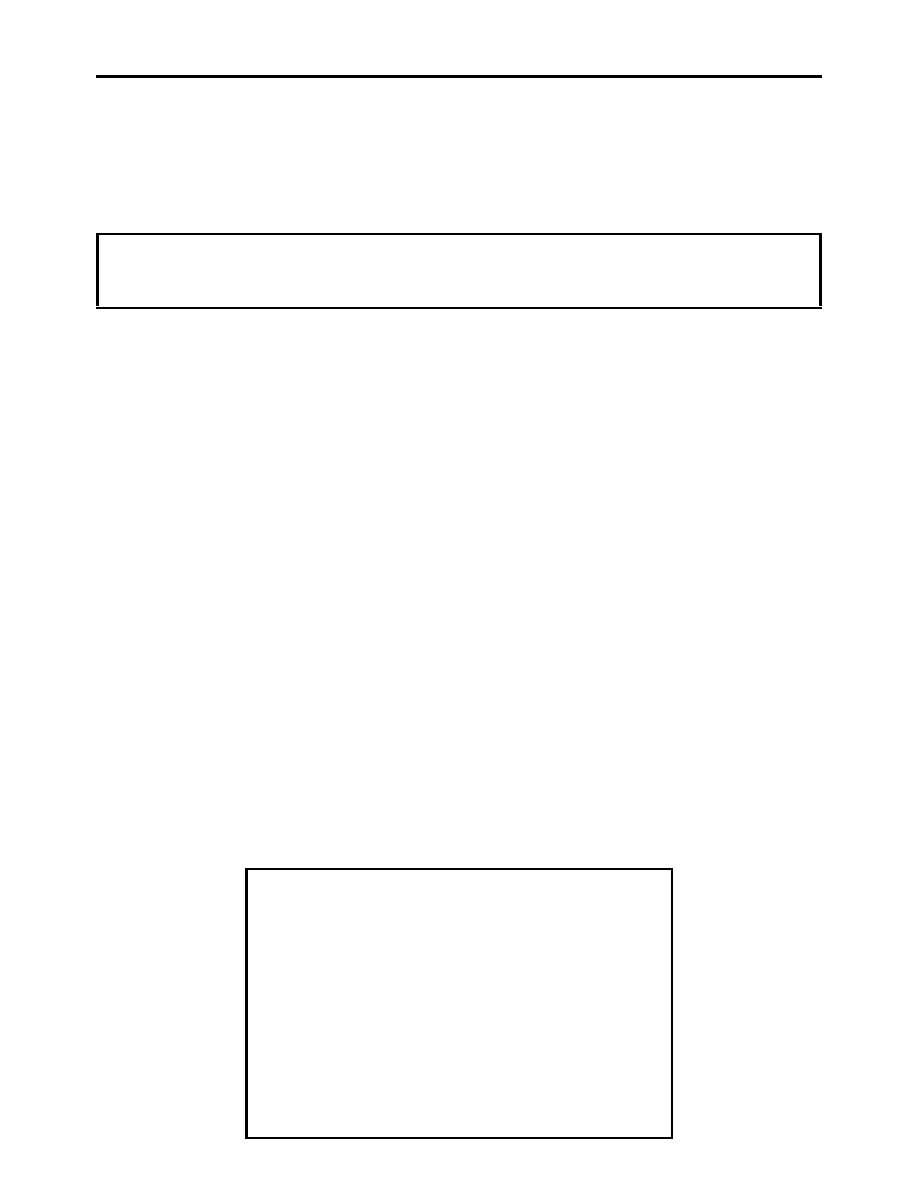
FOREWORD
This Supplementary Service Manual has been prepared to introduce new service and new data for
the YFS200P. For complete information on service procedures, it is necessary to use this Supple-
mentary Service Manual together with the following manual.
YFS200U SERVICE MANUAL: 2XJ-28197-10
YFS200A SUPPLEMENTARY SERVICE MANUAL: 3JM-28197-10
YFS200P
SUPPLEMENTARY
SERVICE MANUAL
2001 by Yamaha Motor Corporation, U.S.A.
First Edition, May 2001
All rights reserved.
Any reproduction or unauthorized use
without the written permission of
Yamaha Motor Corporation, U.S.A.
is expressly prohibited.
Printed in U.S.A.
LIT-11616-15-05
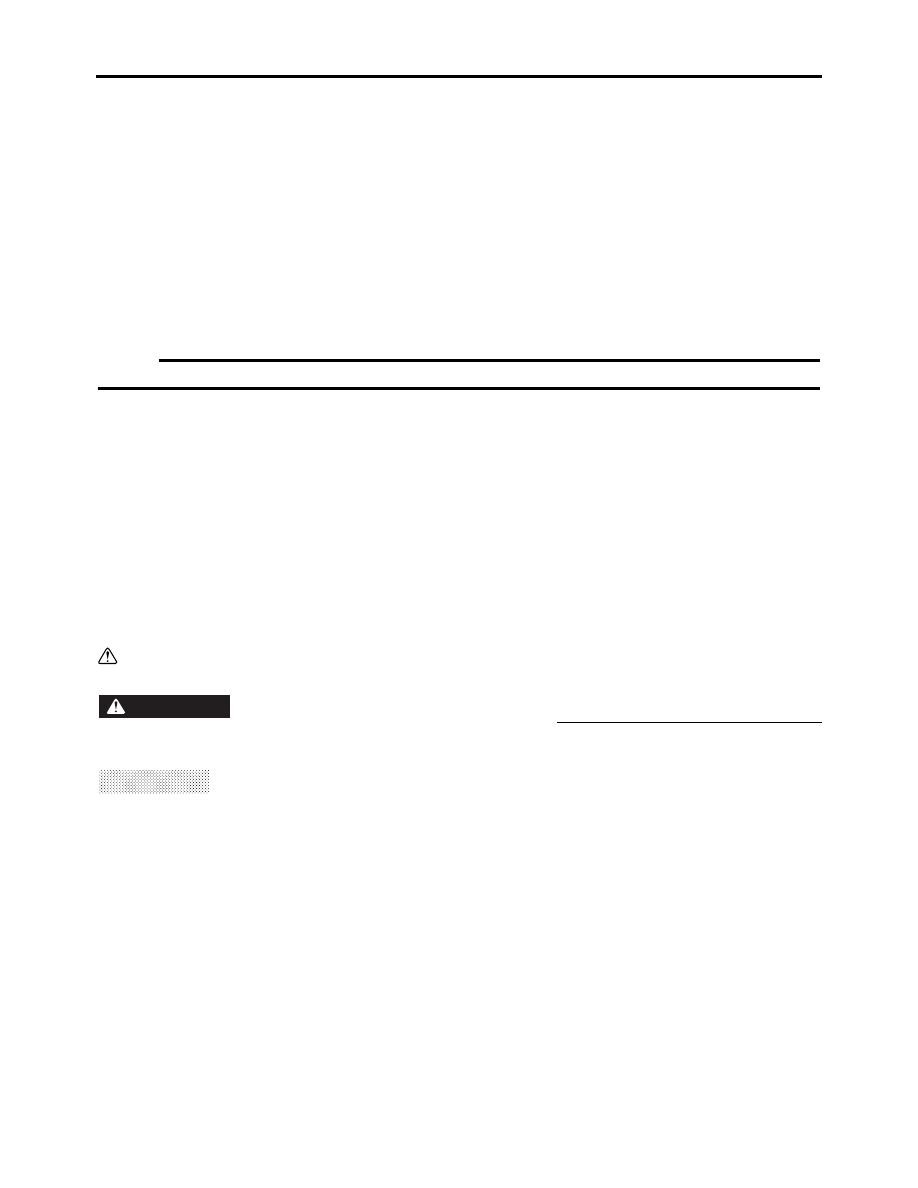
EB001000
NOTICE
This manual was produced by the Yamaha Motor Company primarily for use by Yamaha dealers
and their qualified mechanics. It is not possible to include all the knowledge of a mechanic in one
manual, so it is assumed that anyone who uses this book to perform maintenance and repairs on
Yamaha machine has a basic understanding of the mechanical ideas and the procedures of
machine repair. Repairs attempted by anyone without this knowledge are likely to render the
machine unsafe and unfit for use.
Yamaha Motor Company, Ltd. is continually striving to improve all its models. Modifications and sig-
nificant changes in specifications or procedures will be forwarded to all authorized Yamaha dealers
and will appear in future editions of this manual where applicable.
NOTE:
Designs and specifications are subject to change without notice.
IMPORTANT INFORMATION
Particularly important information is distinguished in this manual by the following notations.
The Safety Alert Symbol means ATTENTION! BECOME ALERT! YOUR
SAFETY IS INVOLVED!
Failure to follow WARNING instructions could result in severe injury or death
to the machine operator, a bystander or a person inspecting or repairing the
machine.
A CAUTION indicates special precautions that must be taken to avoid dam-
age to the machine.
A NOTE provides key information to make procedures easier or clearer.
WARNING
CAUTION:
NOTE:
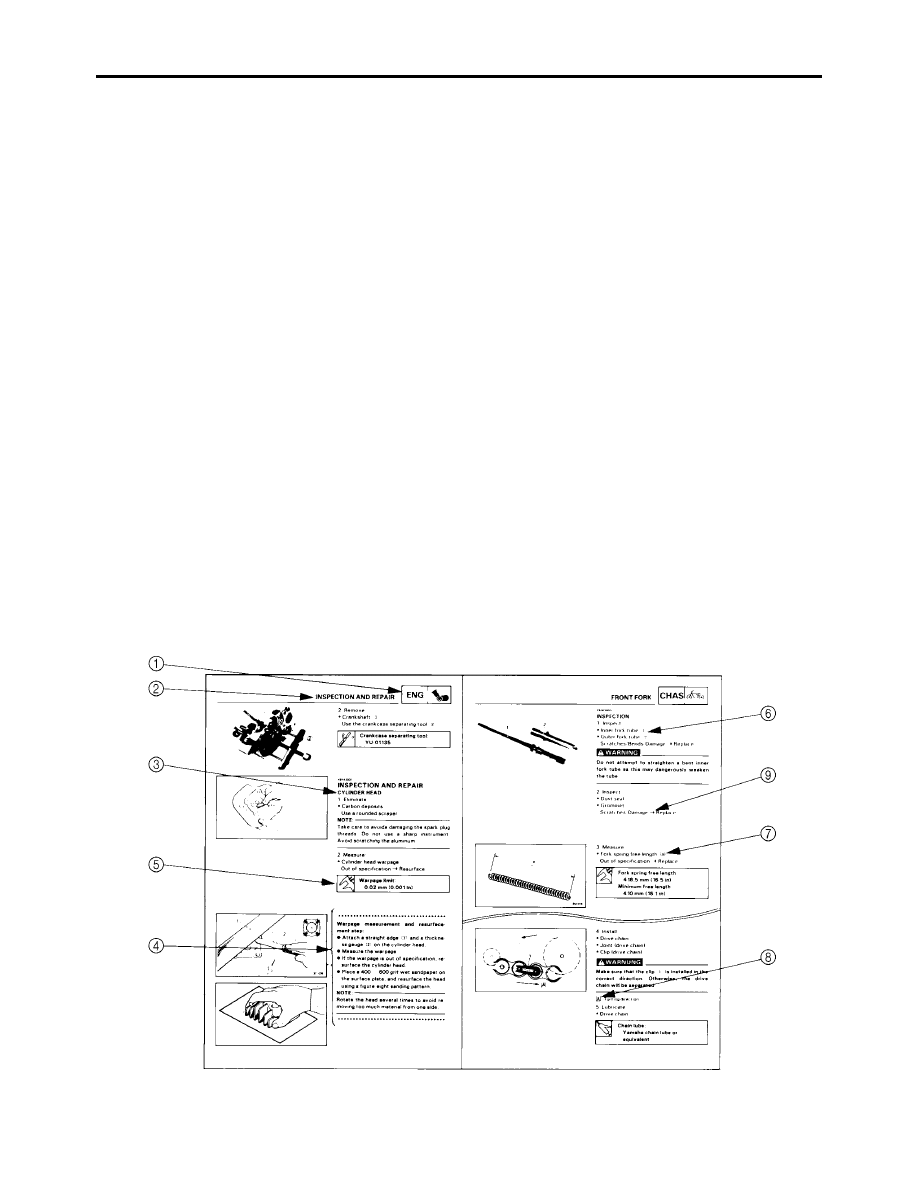
HOW TO USE THIS MANUAL
CONSTRUCTION OF THIS MANUAL
This manual consists of chapters for the main categories of subjects. (See “Illustrated symbols”)
1st title
1:
This is a chapter with its symbol on the upper right of each page.
2nd title
2:
This title appears on the upper of each page on the left of the chapter sym-
bol. (For the chapter “Periodic inspection and adjustment” the 3rd title
appears.)
3rd title
3:
This is a final title.
MANUAL FORMAT
All of the procedures in this manual are organized in a sequential, step-by-step format. The informa-
tion has been compiled to provide the mechanic with an easy to read, handy reference that contains
comprehensive explanations of all disassembly, repair, assembly, and inspections.
A set of particularly important procedure
4 is placed between a line of asterisks “
*
” with each proce-
dure preceded by “
●
”.
IMPORTANT FEATURES
●
Data and a special tool are framed in a box preceded by a relevant symbol
5.
●
An encircled numeral
6 indicates a part name, and an encircled alphabetical letter data or an
alignment mark
7, the others being indicated by an alphabetical letter in a box 8.
●
A condition of a faulty component will precede an arrow symbol
9 and the course of action will fol-
low it.
EXPLODED DIAGRAM
Each chapter provides exploded diagrams before each disassembly section for ease in identifying
correct disassembly and assembly procedures.
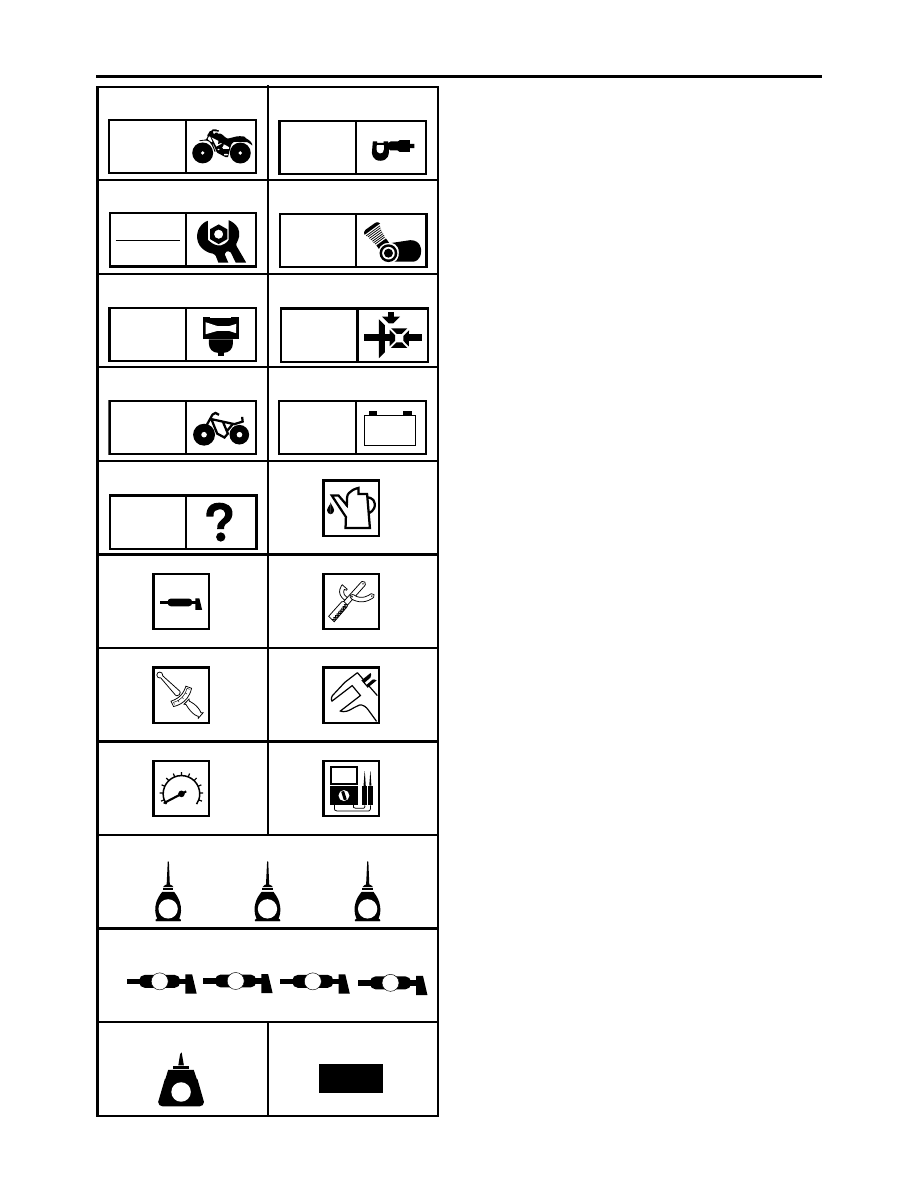
EB003000
ILLUSTRATED SYMBOLS
Illustrated symbols
1 to 9 are printed on the
top right of each page and indicate the subject
of each chapter.
1 General information
2 Specifications
3 Periodic checks and adjustments
4 Engine
5 Carburetion
6 Drive train
7 Chassis
8 Electrical
9 Troubleshooting
Illustrated symbols
0 to F are used to identify
the specifications appearing in the text.
0 Filling fluid
A Lubricant
B Special tool
C Torque
D Wear limit, clearance
E Engine speed
F
Ω
, V, A
Illustrated symbols
G to M in the exploded
diagrams indicate the types of lubricants and
lubrication points.
G Apply engine oil
H Apply gear oil
I Apply molybdenum disulfide oil
J Apply wheel bearing grease
K Apply lightweight lithium soap base grease
L Apply molybdenum disulfide grease
M Apply silicon grease
Illustrated symbols
N to O in the exploded
diagrams indicate where to apply a locking
agent
N and when to install a new part O.
N Apply the locking agent (LOCTITE
)
O Replace
1
2
3
4
5
6
7
8
9
0
A
B
C
D
E
F
G
H
I
J
N
O
GEN
INFO
SPEC
CHK
ADJ
ENG
CARB
DRIV
CHAS
–
+
ELEC
TRBL
SHTG
T
R
.
.
E
G
M
B
LS
M
S
K
L
M
LT
New
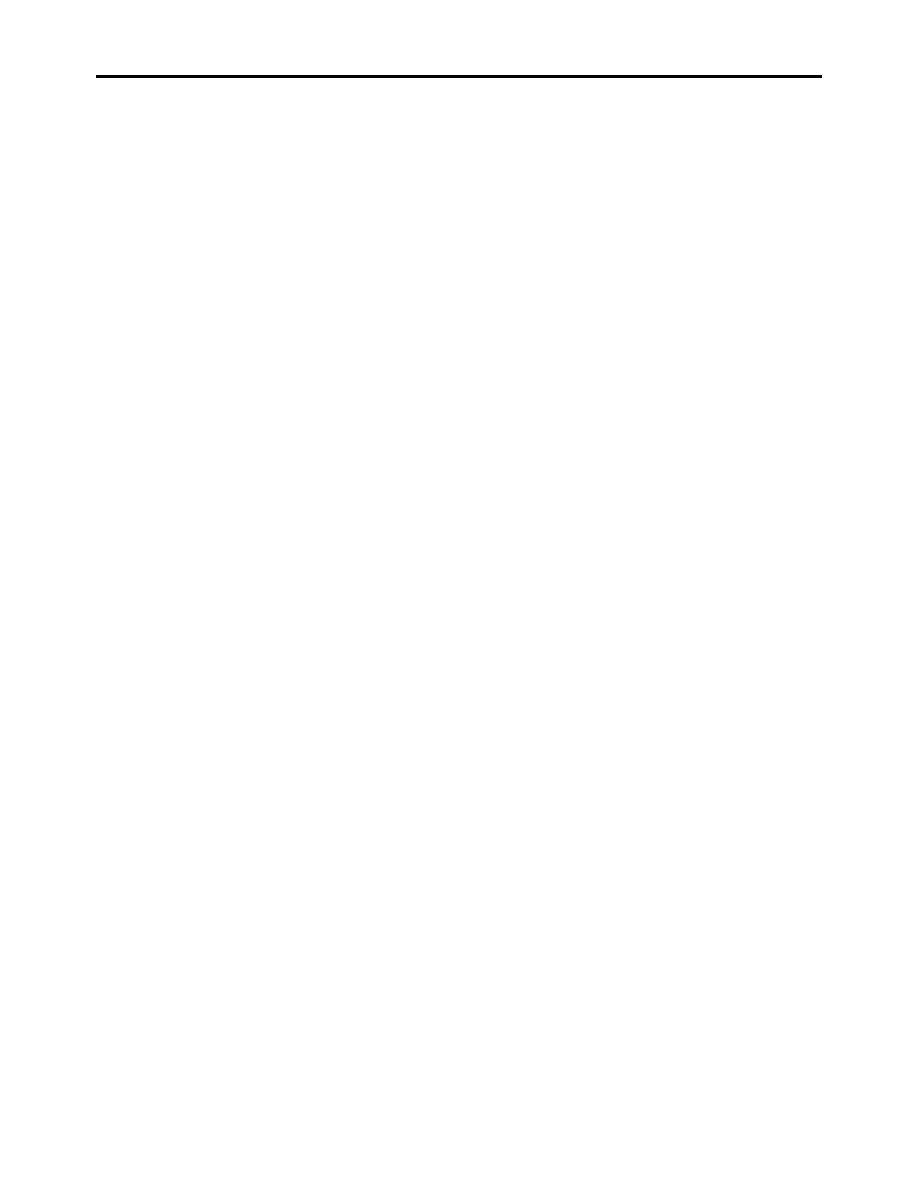
CONTENTS
GENERAL INFORMATION............................................................................... 1
MACHINE IDENTIFICATION .................................................................... 1
MODEL LABEL ..................................................................................... 1
SPECIFICATIONS ............................................................................................ 2
GENERAL SPECIFICATIONS .................................................................. 2
MAINTENANCE SPECIFICATIONS ......................................................... 3
ENGINE................................................................................................. 3
CHASSIS............................................................................................... 5
ELECTRICAL ........................................................................................ 5
CABLE ROUTING ..................................................................................... 6
PERIODIC CHECKS AND ADJUSTMENTS .................................................. 11
INTRODUCTION ..................................................................................... 11
PERIODIC MAINTENANCE/LUBRICATION INTERVALS ...................... 11
CHASSIS ................................................................................................. 12
ADJUSTING THE REAR BRAKE LIGHT SWITCH............................. 12
ELECTRICAL.................................................................................................. 13
CHECKING THE SWITCH ...................................................................... 13
CHECKING THE SWITCH .................................................................. 13
CHECKING A SWITCH SHOWN IN THE MANUAL ........................... 13
SIGNAL SYSTEM.................................................................................... 14
CIRCUIT DIAGRAM ............................................................................ 14
CHECKING THE SIGNAL SYSTEM ................................................... 15
YFS200P WIRING DIAGRAM
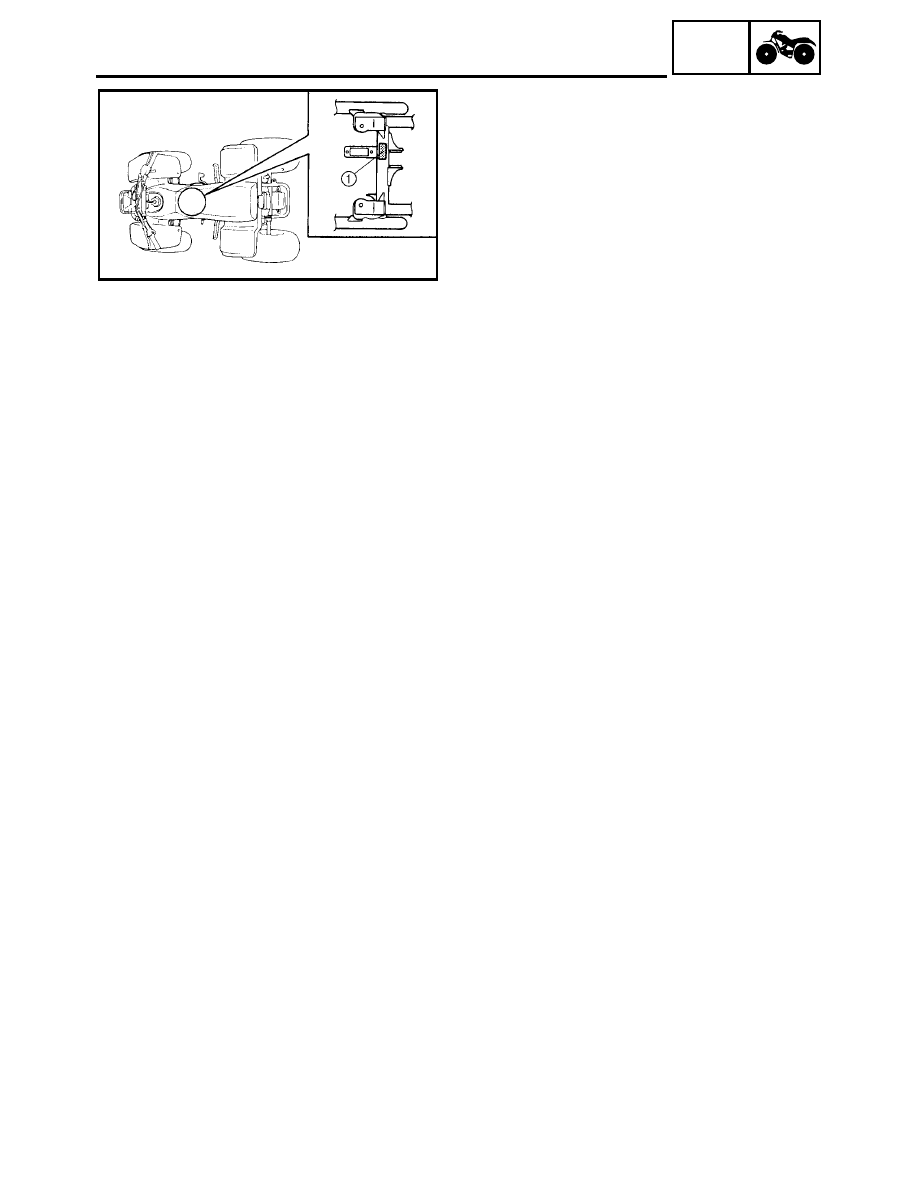
– 1 –
GEN
INFO
MACHINE IDENTIFICATION
GENERAL INFORMATION
MACHINE IDENTIFICATION
MODEL LABEL
The model label
1 is affixed to the frame. This
information will be needed to order spare
parts.
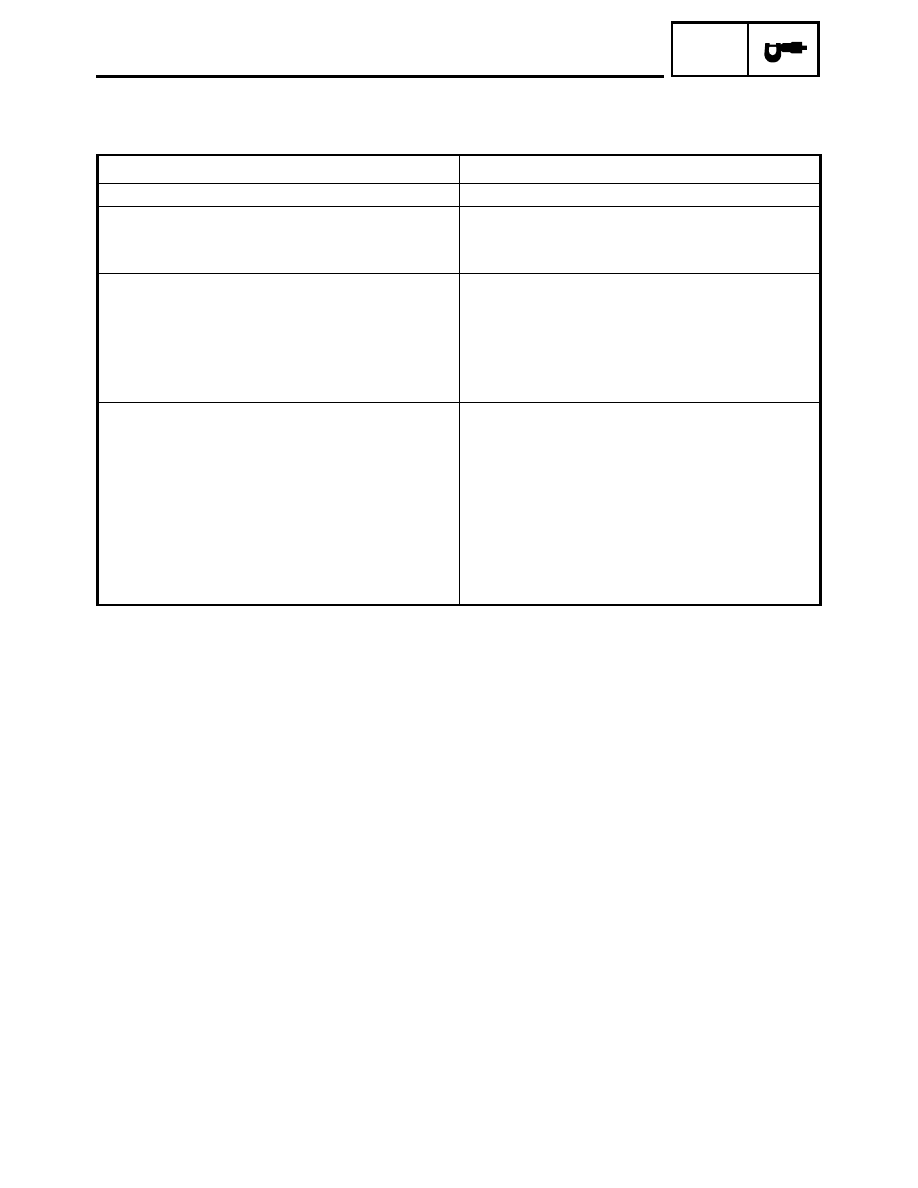
– 2 –
SPEC
GENERAL SPECIFICATIONS
SPECIFICATIONS
GENERAL SPECIFICATIONS
Model
YFS200P
Model code number
5KJ7 (USA)
Spark plug:
Type/manufacturer
BR8ES/NGK
Spark plug gap
0.7 ~ 0.8 mm (0.028 ~ 0.031 in)
Tire:
Type
Tubeless
Size: Front
AT21
× 7 – 10 DUNLOP KT851A
CHENG SHIN C873N
Rear
AT21
× 10 – 8 DUNLOP KT895A
CHENG SHIN C874N
Electrical:
Ignition system
C.D.I.
Generator system
C.D.I. magneto
Headlight type
Bulb type
Headlight bulb type
Incandescence
Bulb wattage
× quantity:
Headlight
12 V 45 W/45 W
× 1
Tail/brake light
12 V 5 W/21 W
× 1
Indicator light “OIL LEVEL”
12 V 3.4 W
× 1
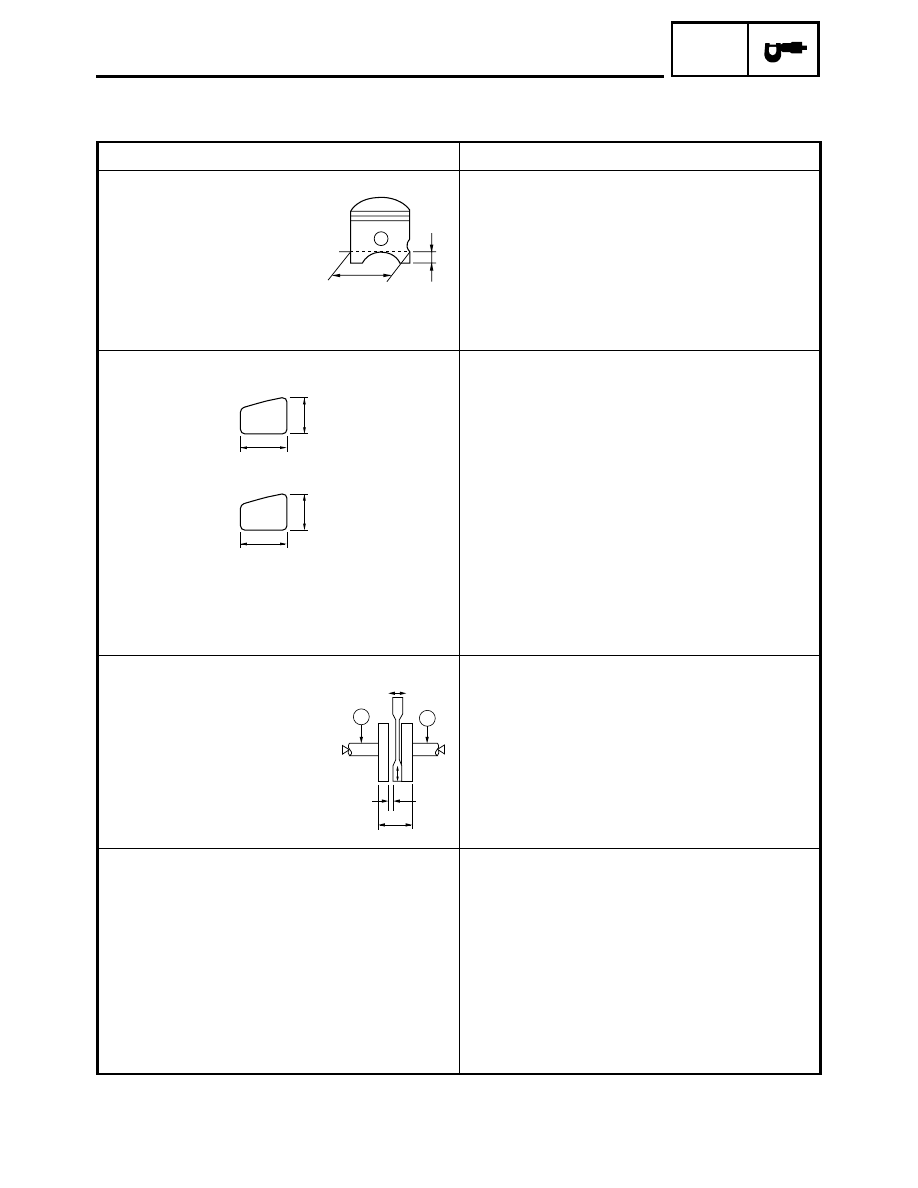
– 3 –
SPEC
MAINTENANCE SPECIFICATIONS
MAINTENANCE SPECIFICATIONS
ENGINE
Model
YFS200P
Piston:
Piston size “D”
65.940 ~ 66.000 mm (2.596 ~ 2.598 in)
Measuring point “H”
10 mm (0.39 in)
Piston off-set
0 mm (0 in)
Piston-to-cylinder clearance
0.035 ~ 0.040 mm (0.0014 ~ 0.0016 in)
<Limit>
0.100 mm (0.0039 in)
Oversize 1st
66.25 mm (2.608 in)
2nd
66.50 mm (2.618 in)
Piston ring:
Sectional sketch
Top ring
Keystone
B = 1.2 mm (0.047 in)
T = 2.8 mm (0.110 in)
2nd ring
Keystone
B = 1.2 mm (0.047 in)
T = 2.8 mm (0.110 in)
End gap (Installed)
Top ring
0.20 ~ 0.40 mm (0.008 ~ 0.016 in)
2nd ring
0.20 ~ 0.40 mm (0.008 ~ 0.016 in)
Side clearance
Top ring
0.03 ~ 0.05 mm (0.0012 ~ 0.0020 in)
2nd ring
0.03 ~ 0.05 mm (0.0012 ~ 0.0020 in)
Crankshaft:
Crank width “A”
57.90 ~ 57.95 mm (2.280 ~ 2.281 in)
<Runout limit “C”>
<0.03 mm (0.0012 in)>
Big end side clearance “D”
0.2 ~ 0.7 mm (0.008 ~ 0.028 in)
Big end radial clearance “E”
0.021 ~ 0.035 mm (0.0008 ~ 0.0014 in)
Small end free play “F”
0.8 ~ 1.0 mm (0.031 ~ 0.039 in)
Clutch:
Friction plate thickness/quantity
2.92 ~ 3.08 mm (0.115 ~ 0.121 in)/7 pcs.
<Wear limit>
<2.8 mm (0.110 in)>
Clutch plate thickness/quantity
1.05 ~ 1.35 mm (0.041 ~ 0.053 in)/6 pcs.
<Warp limit>
<0.05 mm (0.002 in)>
Clutch spring free length/quantity
34.5 mm (1.36 in)/5 pcs.
Clutch spring minimum length
30.0 mm (1.18 in)
Clutch housing radial clearance
0.015 ~ 0.049 mm (0.0006 ~ 0.0019 in)
Clutch release method
Inner push, cam push
<Push rod bending limit>
<0.15 mm (0.006 in)>
D
H
B
T
B
T
C
C
F
D
A
E
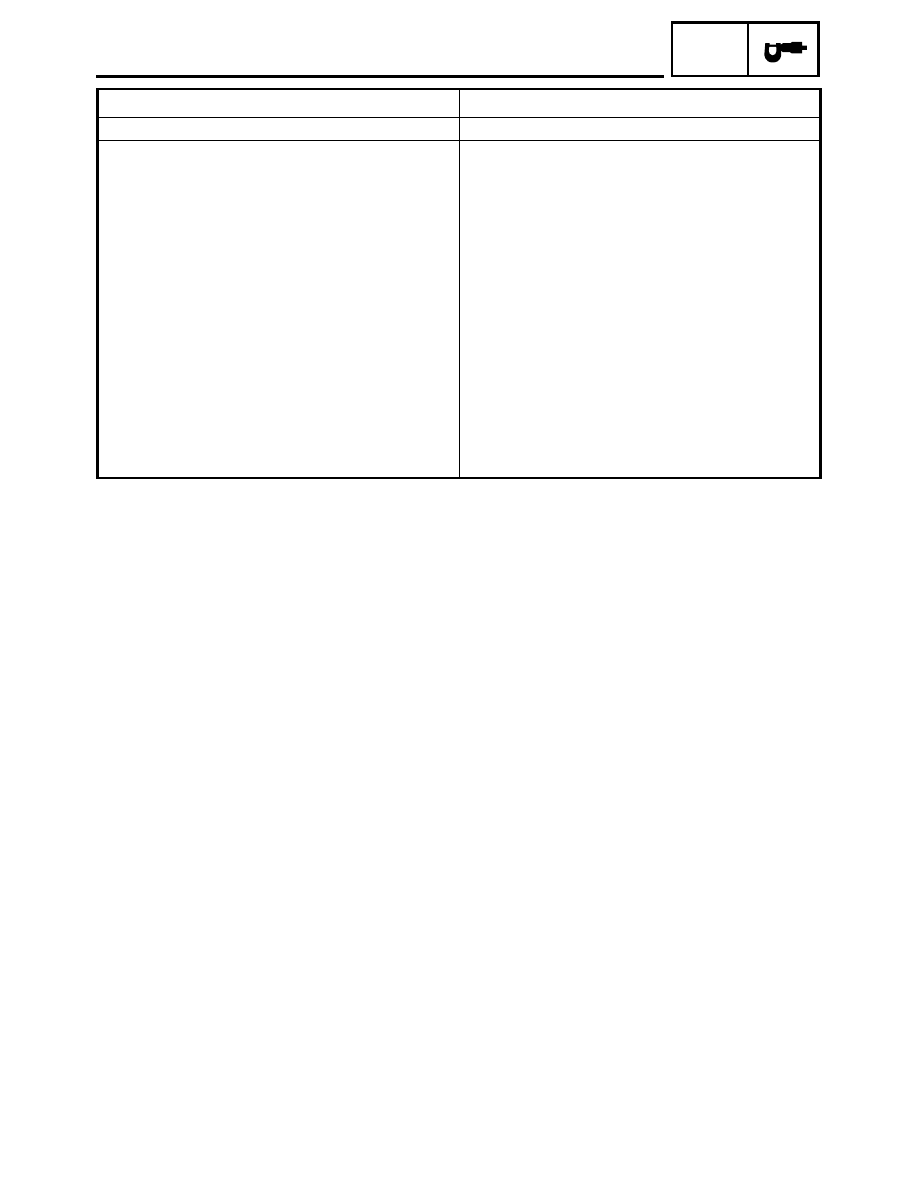
– 4 –
SPEC
MAINTENANCE SPECIFICATIONS
Air filter oil grade
Yamalube 2 or air cooled 2-stroke engine oil
Carburetor:
I.D. mark
2XJ01
Main jet
(M.J.)
#230
Main air jet
(M.A.J.)
ø0.7
Jet needle-clip position
(J.N.)
5J22-2
Needle jet
(N.J.)
P-6 (#345)
Cutaway
(C.A.)
2.0
Pilot outlet
(P.O.)
0.6
Pilot jet
(P.J.)
#32.5
Bypass 1
(B.P.1.)
0.8
× 3.75
Valve seat size
(V.S.)
ø2.8
Starter jet
(G.S.)
#45
Float height
(F.H.)
20.5 ~ 21.5 mm (0.81 ~ 0.85 in)
Fuel level
(F.L.)
0.5 ~ 1.5 mm (0.02 ~ 0.06 in)
Engine idling speed
1,450 ~ 1,550 r/min
Model
YFS200P
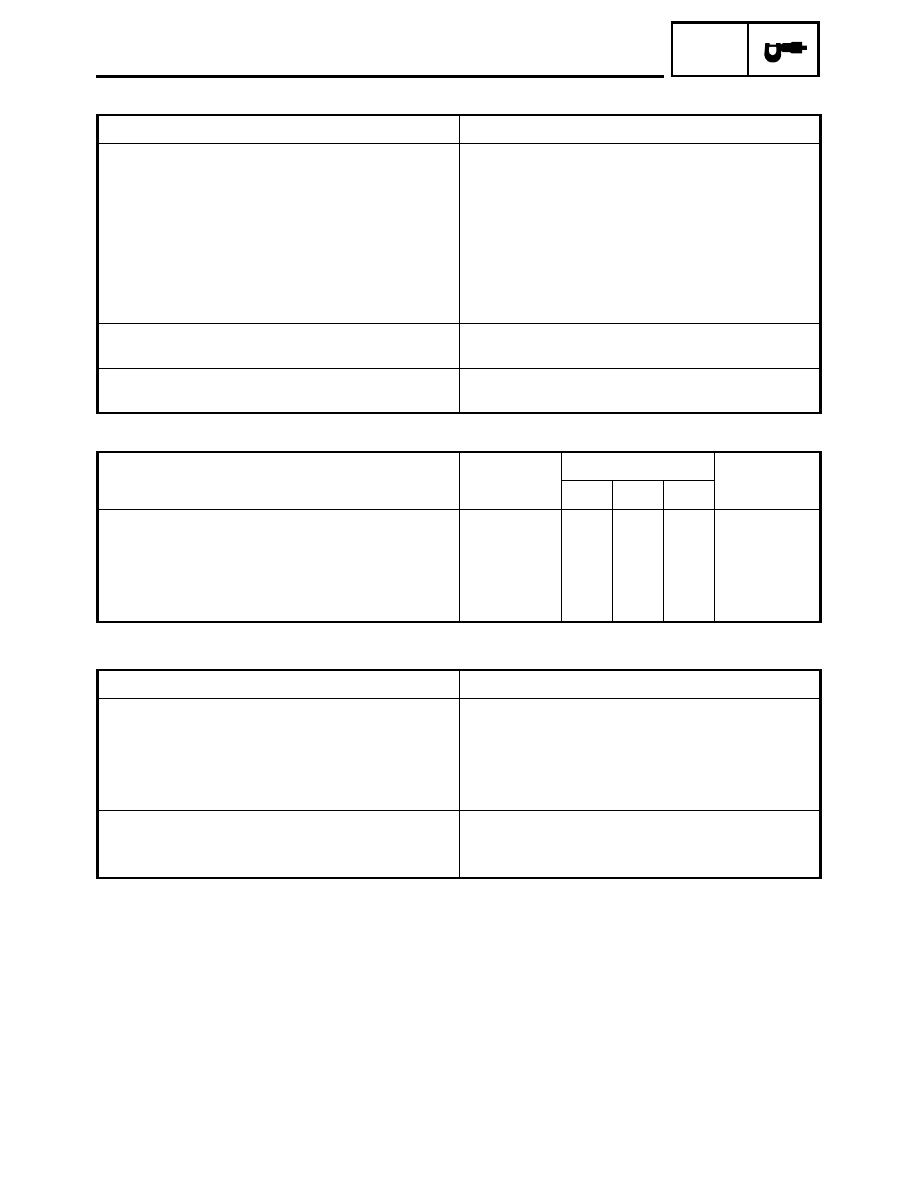
– 5 –
SPEC
MAINTENANCE SPECIFICATIONS
CHASSIS
Tightening torque
ELECTRICAL
Model
YFS200P
Rear suspension:
Shock absorber travel
80 mm (3.15 in)
Spring free length
248 mm (9.76 in)
Spring rate
K1
44.1 N/mm (4.50 kg/mm, 252.0 lb/in)
K2
83.4 N/mm (8.50 kg/mm, 476.0 lb/in)
Stroke
K1
0 ~ 58.0 mm (0 ~ 2.28 in)
K2
58.0 ~ 105.0 mm (2.28 ~ 4.13 in)
Optional spring
No.
Brake lever:
Brake lever free play
3 ~ 5 mm (0.12 ~ 0.20 in) at lever pivot
Clutch lever:
Clutch lever free play
2 ~ 3 mm (0.08 ~ 0.12 in) at lever pivot
Parts to be tightened
Thread size
Tightening torque
Remarks
Nm
m · kg ft · lb
Front arm (lower and upper) and frame
M10
× 1.25
32
3.2
23
Steering knuckle and ball joint (front lower arm)
M10
× 1.25
25
2.5
18
Steering knuckle and ball joint (front upper arm)
M10
× 1.25
48
4.8
35
Footrest
M10
× 1.25
64
6.4
46
Rear bumper
M8
× 1.25
23
2.3
17
Model
YFS200P
Ignition coil:
Model/manufacturer
2JN/YAMAHA
Minimum spark gap
6 mm (0.24 in)
Primary coil resistance
0.18 ~ 0.28
Ω at 20 °C (68 °F)
Secondary coil resistance
6.32 ~ 9.48 k
Ω at 20 °C (68 °F)
Spark plug cap:
Type
Resin type
Resistance
5 k
Ω
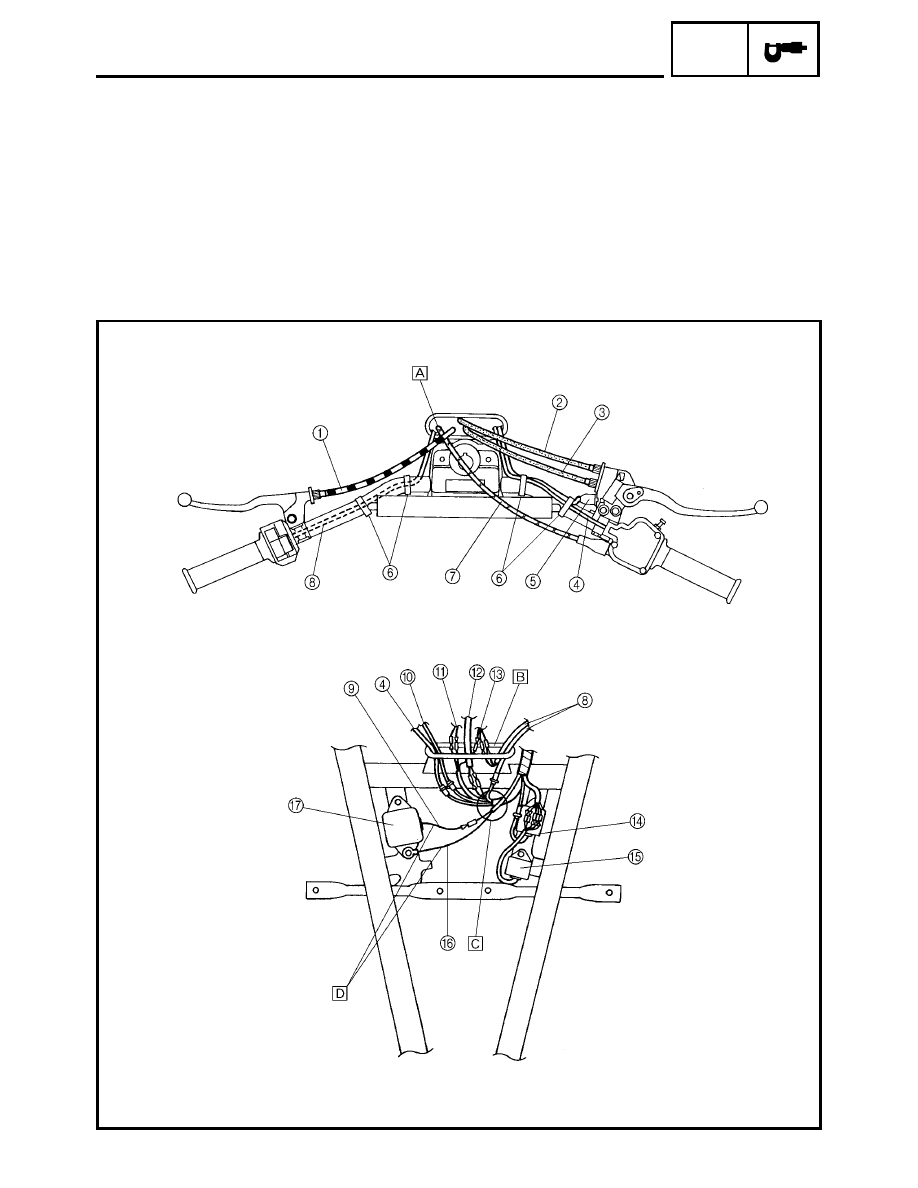
– 6 –
SPEC
CABLE ROUTING
1 Clutch cable
2 Parking brake cable
3 Front brake cable
4 Throttle switch lead
5 Front brake light switch
6 Band
7 Throttle cable
8 Handlebar switch lead (left)
9 Voltage regulator lead
0 Front brake light switch lead
A Oil indicator light lead
B Main switch lead
C Headlight lead
D Control unit
E CDI unit
F Ground lead
G Voltage regulator
È The throttle cable should be
routed behind the clutch cable,
and on the left side of the guide.
É Route all leads behind the cables
and through the cable guide.
Ê Route all leads toward the CDI
unit side.
Ë The ground and voltage regula-
tor leads should be routed in
front of the cables.
CABLE ROUTING
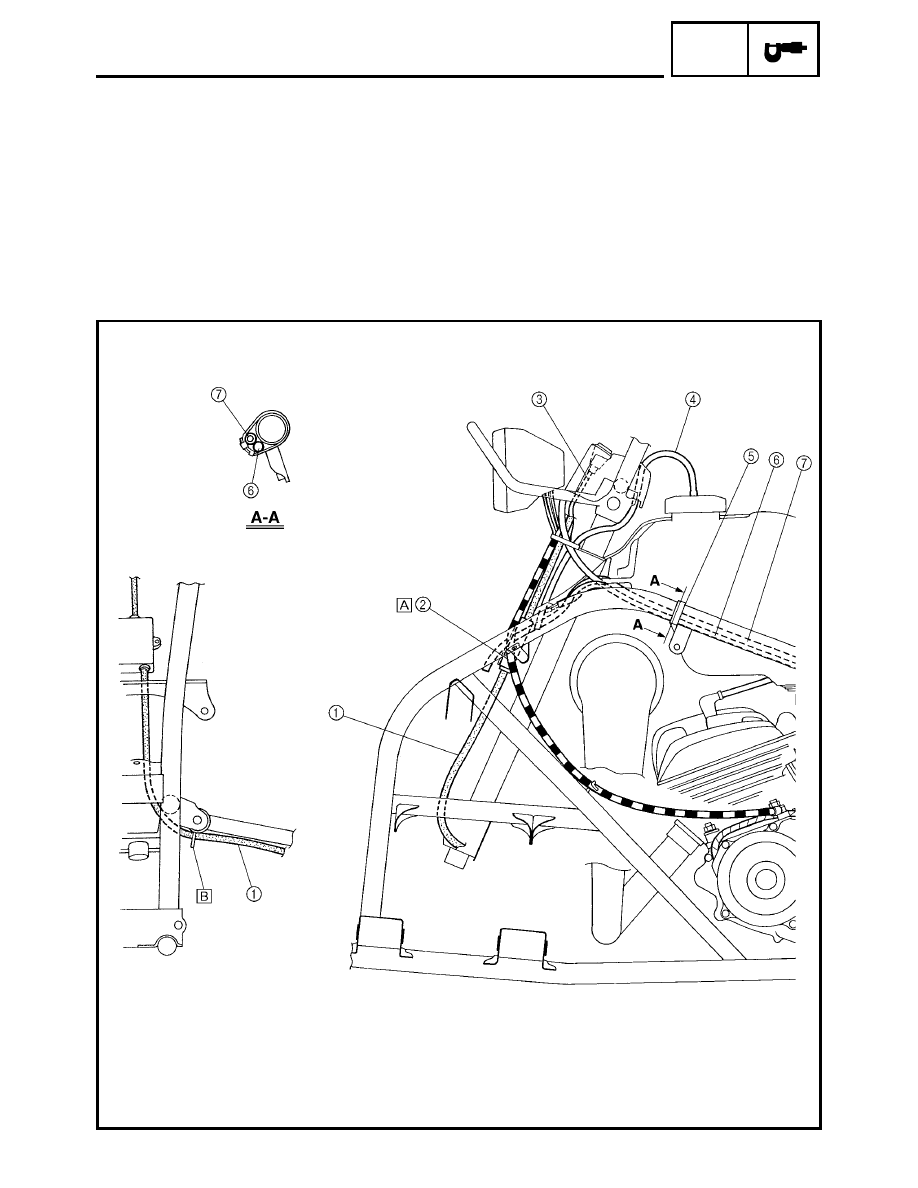
– 7 –
SPEC
1 Front brake cable
2 Clutch cable
3 Main switch lead
4 Fuel breather hose
5 Band
6 Wire harness
7 Crankcase ventilation hose
È Route the clutch cable in front of the fender stay.
É Route the front brake cable through the cable
guide, behind the front shock absorber, and
above the tie rod.
CABLE ROUTING
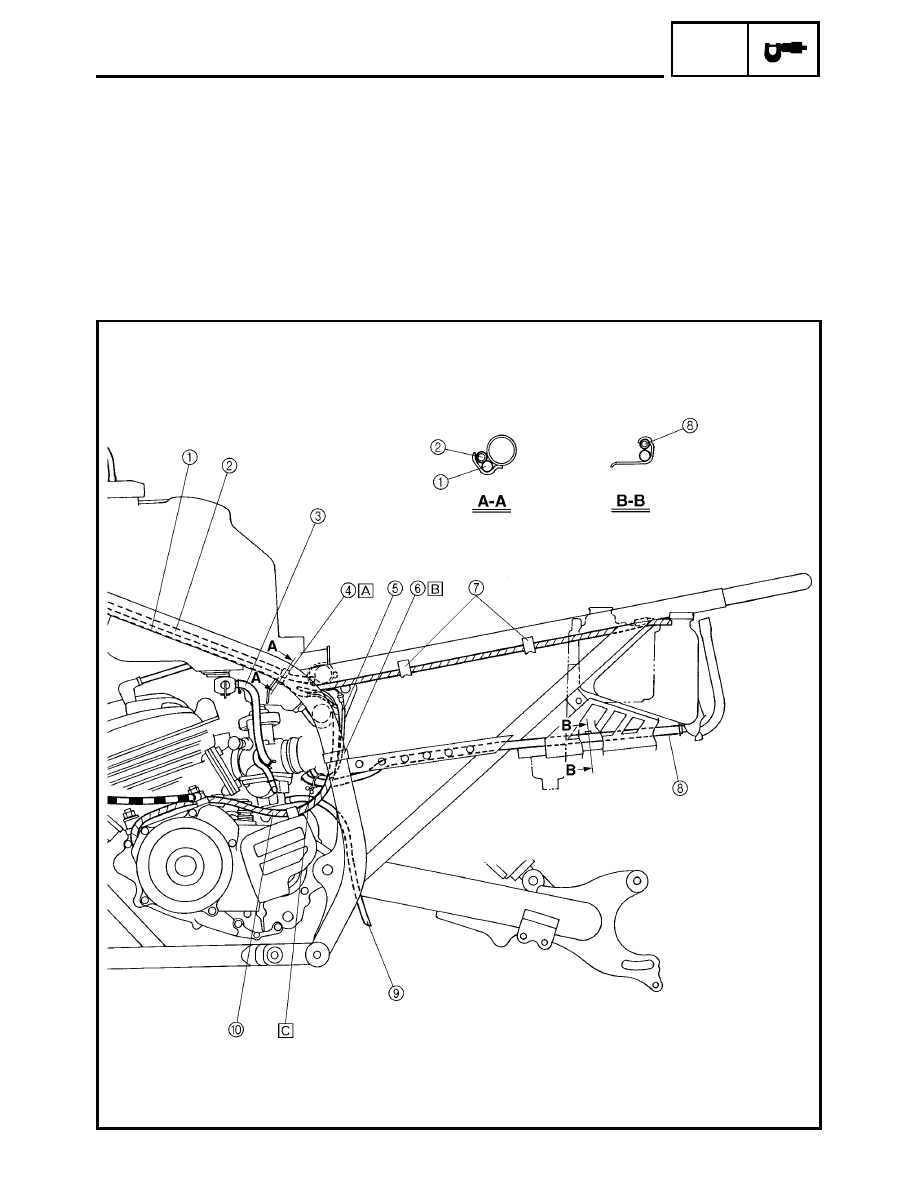
– 8 –
SPEC
1 Wire harness
2 Crankcase ventilation hose
3 Fuel hose
4 Wire holder
5 Rear brake light switch
6 Band
7 Clamp
8 Oil hose
9 Carburetor overflow hose
0 Flywheel magneto lead
È For installing the wire harness, align the posi-
tioning tape with the wire holder.
É The leads should be clamped on the inward half
of the frame pipe.
Ê Clamp the oil hose and rear brake light switch
lead with the plastic clamp.
CABLE ROUTING
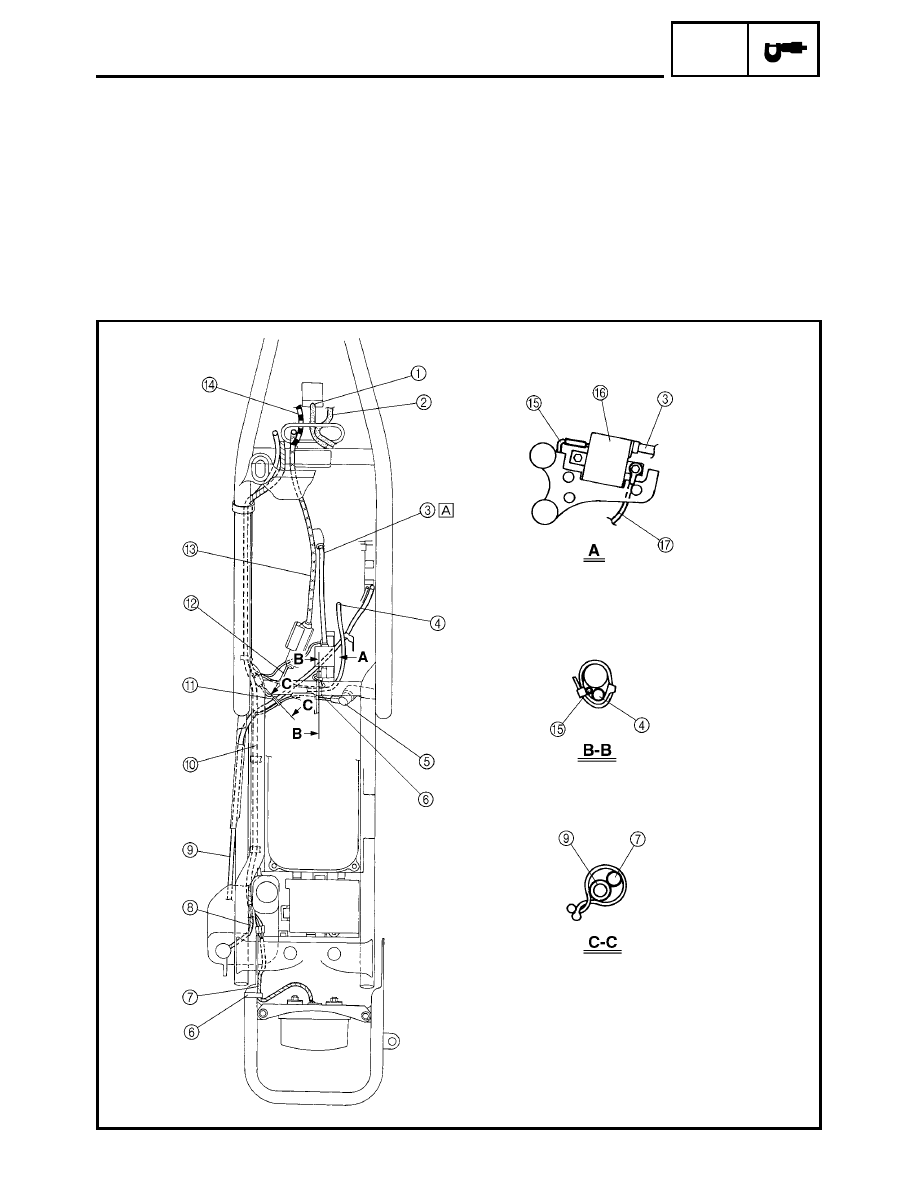
– 9 –
SPEC
1 Front brake cable
2 Parking brake cable
3 Spark plug lead
4 Crankcase ventilation hose
5 Rear brake light switch
6 Band
7 Tail/brake light lead
8 Oil level gauge lead
9 Oil hose
0 Wire harness
A Clamp
B Throttle switch lead
C Throttle cable
D Clutch cable
E Ignition coil lead
F Ignition coil
G Ground lead
È Place the slack of the spark plug lead toward the
left side of the frame.
CABLE ROUTING
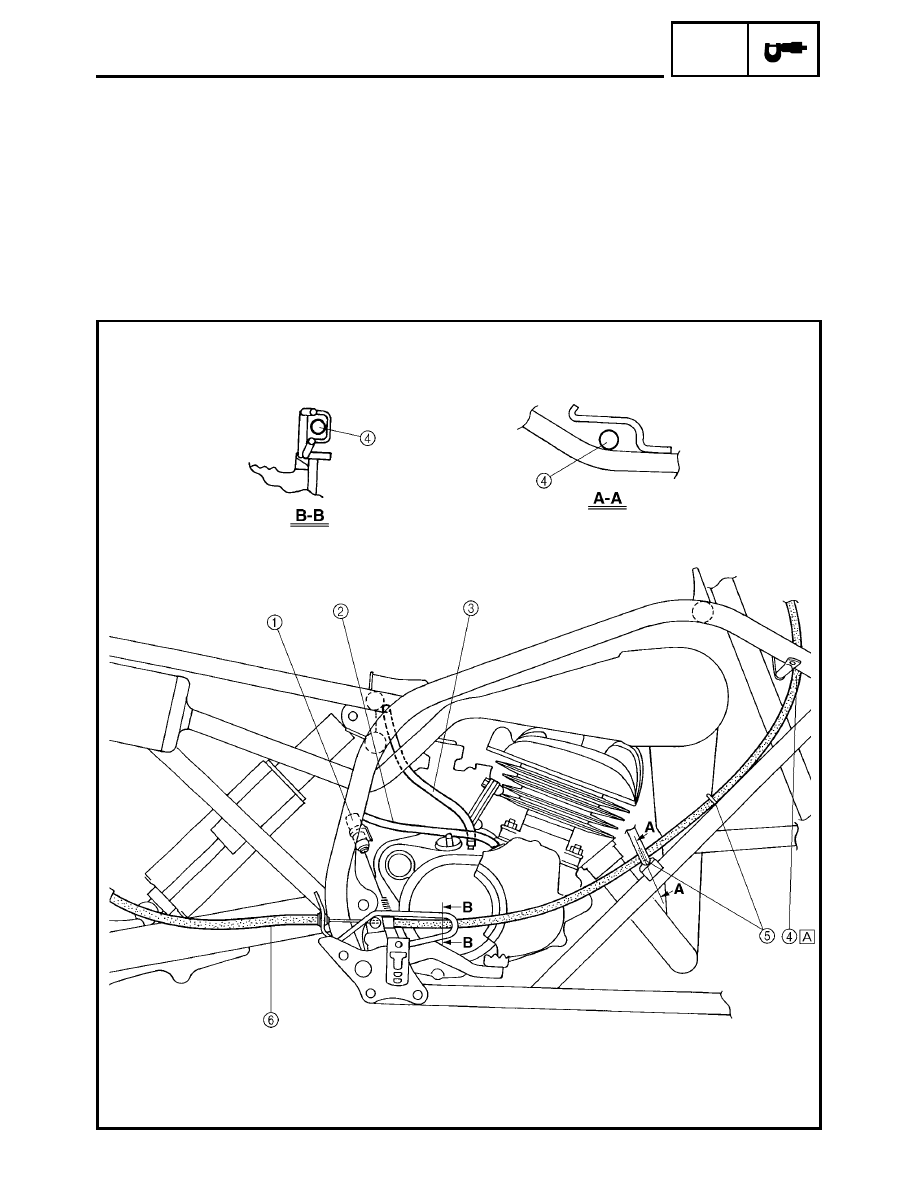
– 10 –
SPEC
1 Rear brake light switch
2 Oil hose
3 Crankcase ventilation hose
4 Parking brake cable
5 Cable guide
6 Rear brake cable
È Route the parking brake cable in front of the
fender stay.
CABLE ROUTING
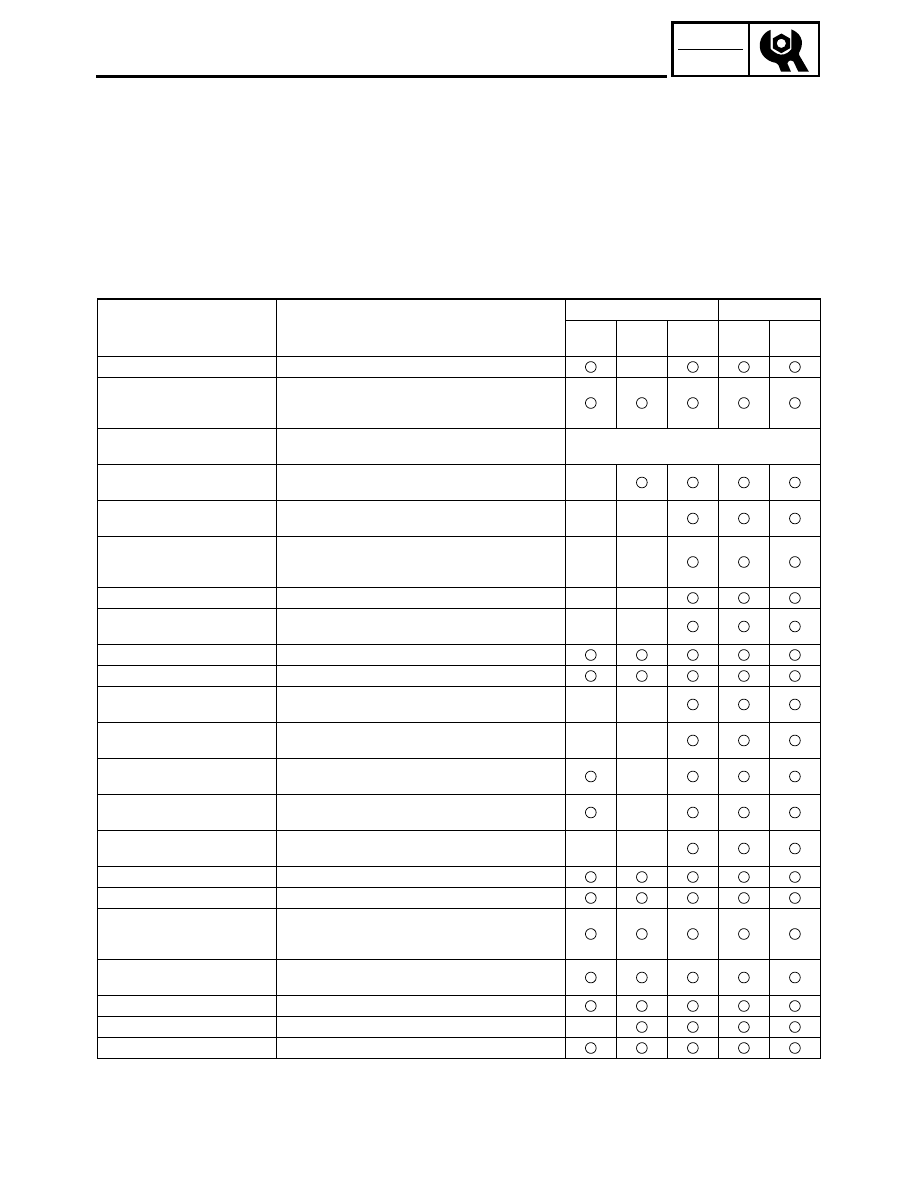
– 11 –
CHK
ADJ
INTRODUCTION/
PERIODIC MAINTENANCE/LUBRICATION INTERVALS
EB300000
PERIODIC CHECKS AND ADJUSTMENTS
INTRODUCTION
This chapter includes all information necessary to perform recommended inspections and adjust-
ments. These preventive maintenance procedures, if followed, will ensure more reliable vehicle
operation and a longer service life. The need for costly overhaul work will be greatly reduced. This
information applies to vehicles already in service as well as to new vehicles that are being prepared
for sale. All service technicians should be familiar with this entire chapter.
EB301000
PERIODIC MAINTENANCE/LUBRICATION INTERVALS
Item
Routine
Initial
Every
1
month
3
months
6
months
6
months
1
year
Transmission
• Replace oil.
Spark plug
• Check condition.
• Adjust gap and clean.
• Replace if necessary.
Air filter
• Clean.
• Replace if necessary.
Every 20 ~ 40 hours.
(More often in wet or dusty areas)
* Carburetor
• Check idle speed / starter operation.
• Adjust if necessary.
* Crankcase breather system
• Check breather hose for cracks or damage.
• Replace if necessary.
* Exhaust system
• Check for leakage.
• Retighten if necessary.
• Replace gasket if necessary.
Spark arrester
• Clean.
* Fuel line
• Check fuel hose for cracks or damage.
• Replace if necessary.
Throttle operation
• Inspect and adjust free play if necessary.
Front brake operation
• Inspect and adjust free play if necessary.
* Front brake shoes
• Check wear limit.
• Replace if necessary.
* Rear brake pads
• Check pad wear.
• Replace if necessary.
* Clutch
• Inspect free play and operation.
• Replace if necessary.
Drive chain
• Lubricate, check free play and alignment.
• Replace if necessary.
* Drive chain guard and
rollers
• Check wear and replace if necessary.
* Steering system
• Inspect free play, clean and lubricate.**
* Front and rear suspension
• Inspect and lubricate.**
Tire, wheels
• Inspect air pressure, wheel runout, and tire wear.
• *Inspect bearings.
• *Replace bearings if necessary.
Throttle, control cable
• Check routing and connection.
• *Lubricate.
Outside nuts and bolts
• Retighten.
Frame
• Clean and inspect.
Lighting equipment
• Inspect.
* It is recommended that these items be serviced by a Yamaha dealer.
** Lithium-soap-based grease
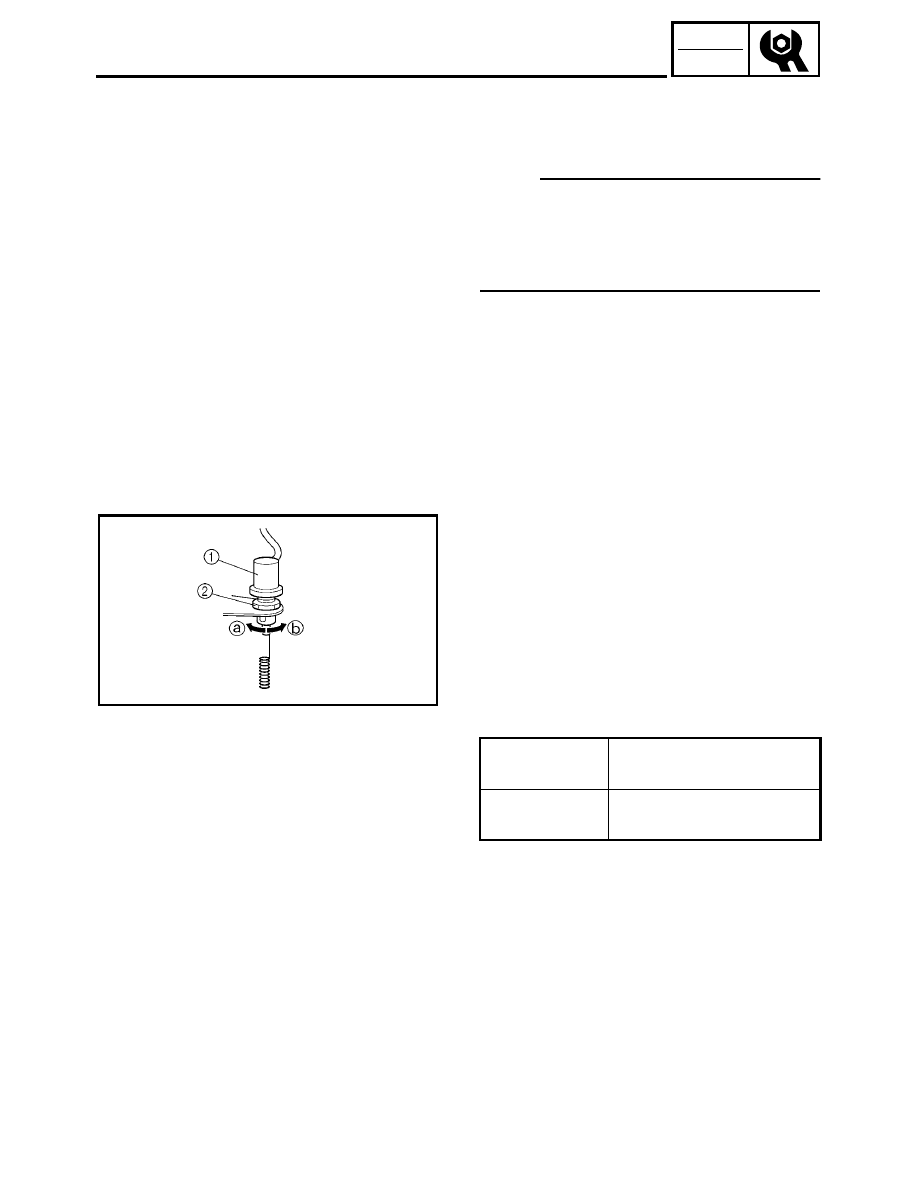
– 12 –
CHK
ADJ
ADJUSTING THE REAR BRAKE LIGHT SWITCH
CHASSIS
ADJUSTING THE REAR BRAKE LIGHT
SWITCH
NOTE:
The rear brake light switch is operated by
movement of the brake pedal.
The rear brake light switch is properly adjusted
when the brake light comes on just before the
braking effect starts.
1.Check:
●
Rear brake light operation timing
Incorrect
→ Adjust.
2.Adjust:
●
Rear brake light operation timing
***********************************************
●
Hold the main body
1 of the rear brake light
switch so that it does not rotate and turn the
adjusting nut
2 in direction a or b until the
rear brake light comes on at the proper time.
***********************************************
Direction
a
Brake light comes on
sooner.
Direction
b
Brake light comes on
later.
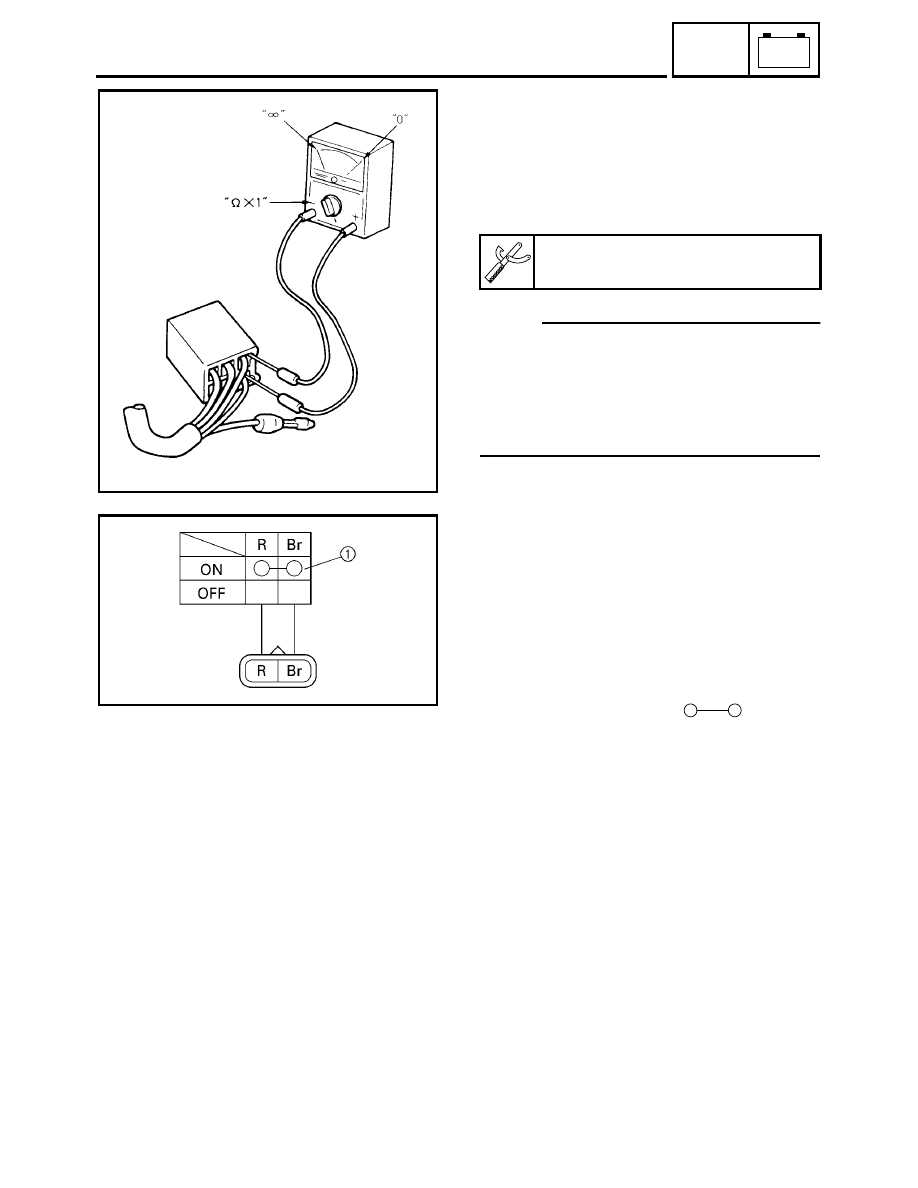
– 13 –
–
+
ELEC
CHECKING THE SWITCH
ELECTRICAL
CHECKING THE SWITCH
CHECKING THE SWITCH
Use a pocket tester to check the terminals for
continuity. If the continuity is faulty at any
point, replace the switch.
NOTE:
●
Set the pocket tester to “0” before starting
the test.
●
The pocket tester should be set to the
“Ω × 1”
range when testing the switch for continuity.
●
Turn the switch on and off a few times when
checking it.
Pocket tester:
P/N. YU-03112, 90890-03112
CHECKING A SWITCH SHOWN IN THE
MANUAL
The terminal connections for switches (main
switch, handlebar switch, engine stop switch,
light switch, etc.) are shown in a chart similar
to the one on the left.
This chart shows the switch positions in the
column and the switch lead colors in the top
row.
For each switch position, “
” indicates
the terminals with continuity.
The example chart shows that:
1
There is continuity between the “Red and
Brown” leads when the switch is set to “ON”.
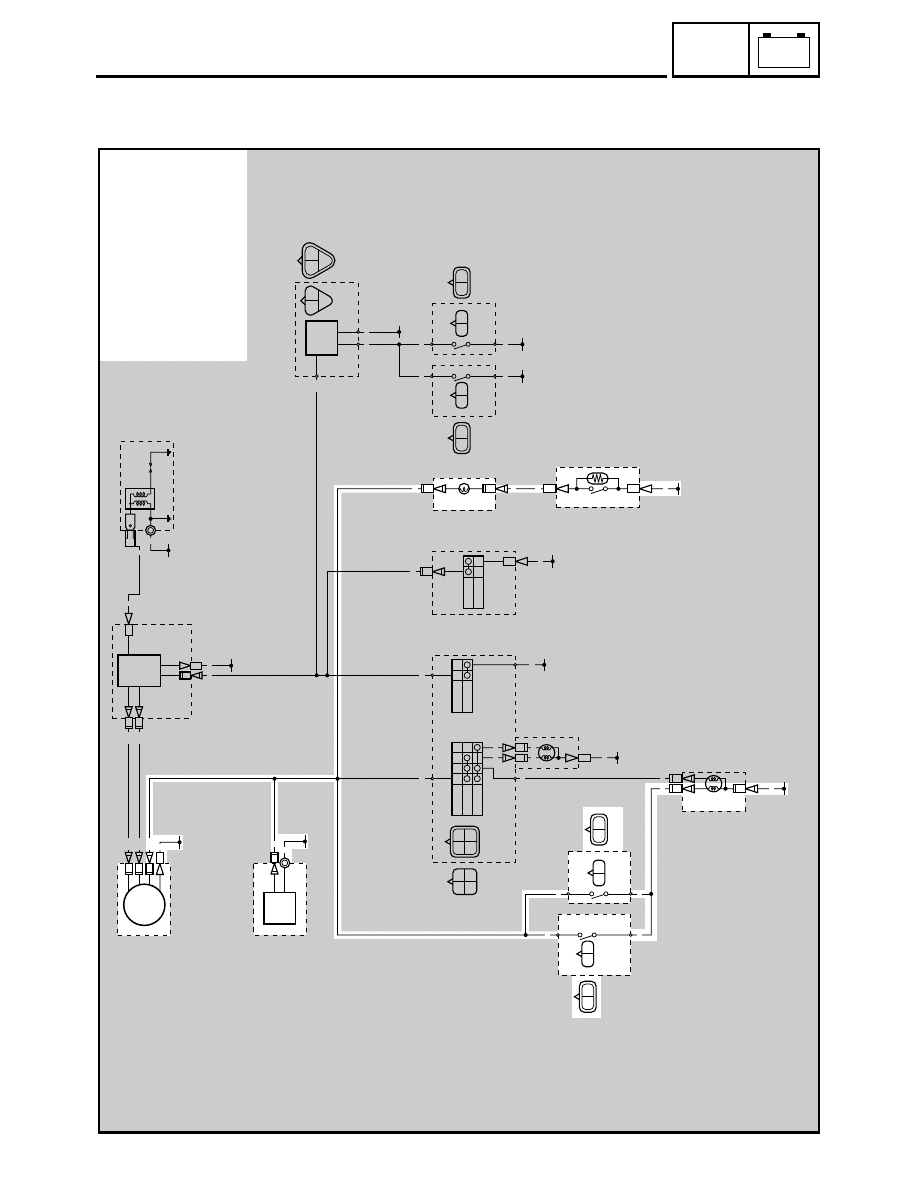
– 14 –
–
+
ELEC
SIGNAL SYSTEM
EB806000
SIGNAL SYSTEM
CIRCUIT DIAGRAM
B
B
Y
/R
B
/R
W
/R
B
/R
B
/W
B
/W
W
/R
OFF
LO
HI
Y
/R
RU
N
OFF
B
/W
BB
/W
Y
/RL
B
/WB
LY
/R
B
/WY
/B
B
Y
/BB
/W
B
Br
Y
Br
Y
O
B
4
5
B
B
OFF
ON
B
/W
B
B
B
O
B
G
Y
G
Y
L
D
F
CB
A
G
B
Y
L
L
E
YB
r
(BLA
CK)
BB
Br
Y
BB
Y
/B
8
6
BY
/B
Y
/BB
(BLA
CK)
(GRA
Y)
(GRA
Y)
B
B
Y
/B
Y
/B
7
BY
/B
Y
/BB
(BLA
CK)
(BLA
CK)
Br
9
G
G
0
2
3
1
1
CDI m
agn
eto
2
V
o
ltage regulator
9
Oil indicator light
0
Oil level gauge
E
Tail/brake light
F
R
e
ar br
ak
e light switc
h
G
Fr
on
t br
ak
e lig
h
t
s
witch
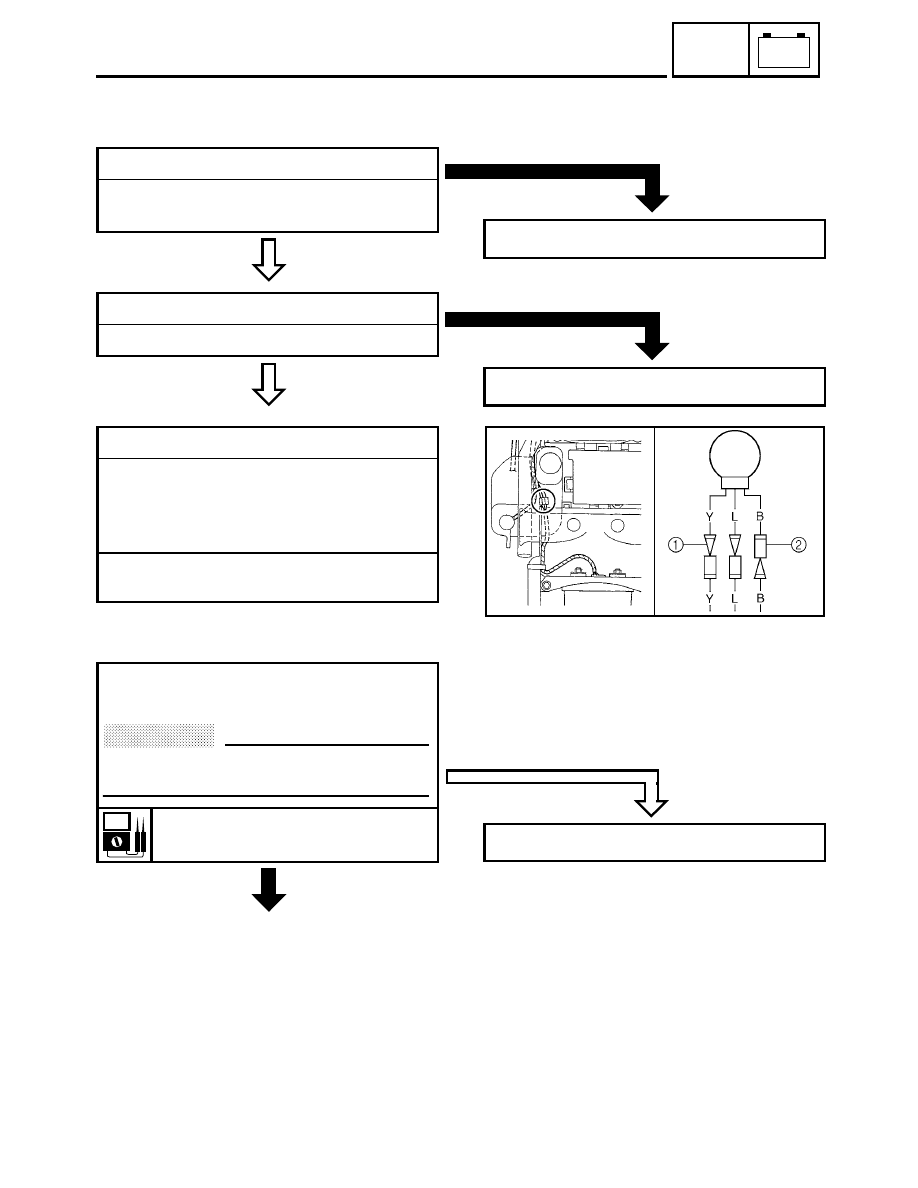
– 15 –
–
+
ELEC
SIGNAL SYSTEM
CHECKING THE SIGNAL SYSTEM
1.If the tail/brake light fails to come on:
CONTINUITY
1.Bulb and bulb socket
●
Check the bulb and bulb socket for continu-
ity.
NO CONTINUITY
Replace the bulb and/or bulb socket.
CONTINUITY
2.Brake light switches
Refer to “CHECKING THE SWITCH”.
NO CONTINUITY
Replace the brake switch.
3.Voltage
●
Connect the tachometer to the spark plug
lead.
●
Connect the pocket tester (DC 20V) to the
bulb socket connector.
Tester (+) lead
→ Yellow terminal 1
Tester (–) lead
→ Black terminal 2
OUT OF
SPECIFICATION
●
Start the engine and accelerate to about
5,000 r/min.
CAUTION:
Do not run the engine in neutral above
6,000 r/min for more than 1 or 2 seconds.
Lighting voltage:
13.5 ~ 14.1 V at 5,000 r/min
*
MEETS SPECIFICATION
The lighting circuit is not faulty.
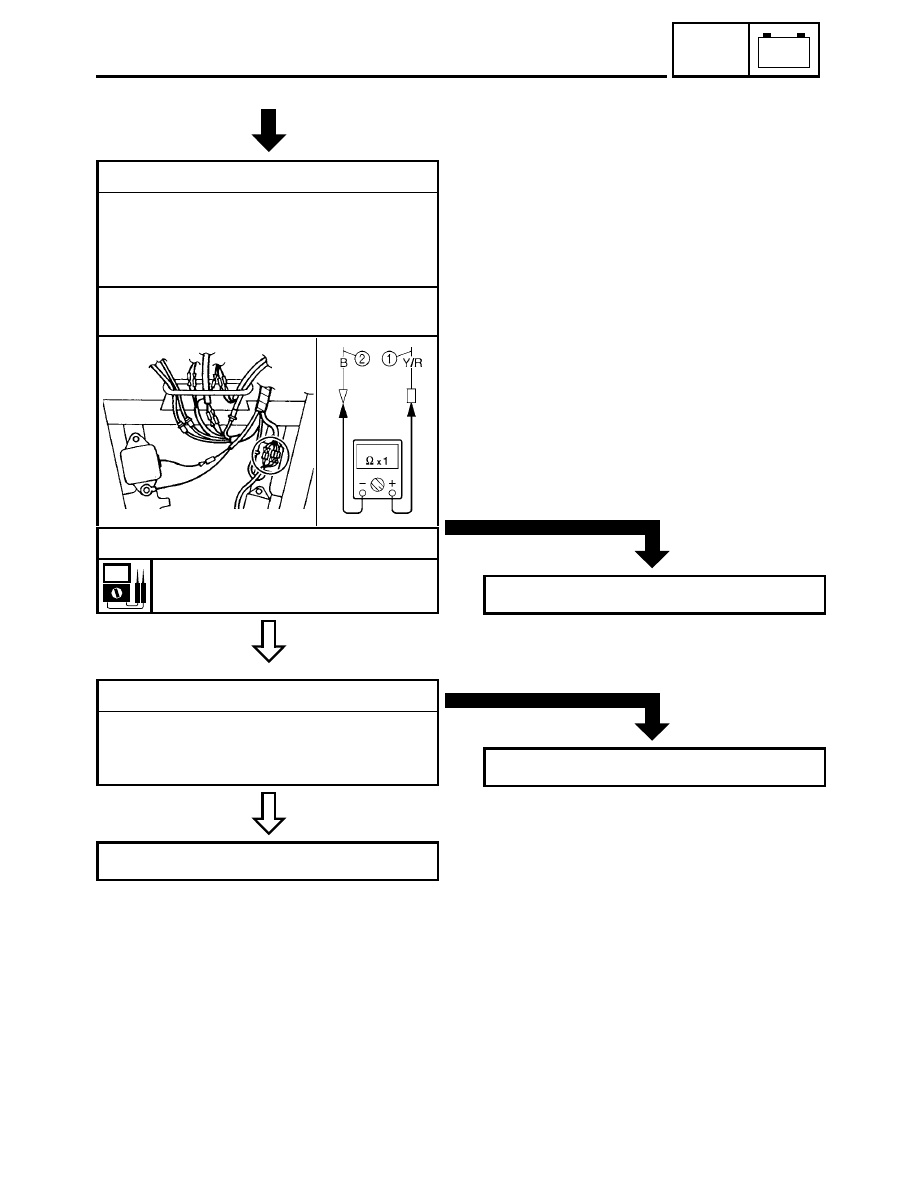
– 16 –
–
+
ELEC
SIGNAL SYSTEM
MEETS
SPECIFICATION
4.Lighting coil resistance
●
Disconnect the CDI magneto leads (Yel-
low/Red and Black).
●
Connect the pocket tester (
Ω × 1) to the
lighting coil leads.
Tester (+) lead
→ Yellow/Red lead 1
Tester (–) lead
→ Black lead 2
●
Measure the lighting coil resistance.
Lighting coil resistance:
0.16 ~ 0.24
Ω at 20 °C (68 °F)
*
OUT OF SPECIFICATION
Replace the stator assembly.
CORRECT
5.Wiring connections
●
Check the connections of the entire lighting
system.
Refer to “CIRCUIT DIAGRAM”.
Replace the voltage regulator.
POOR CONNECTION
Properly connect the lighting system.
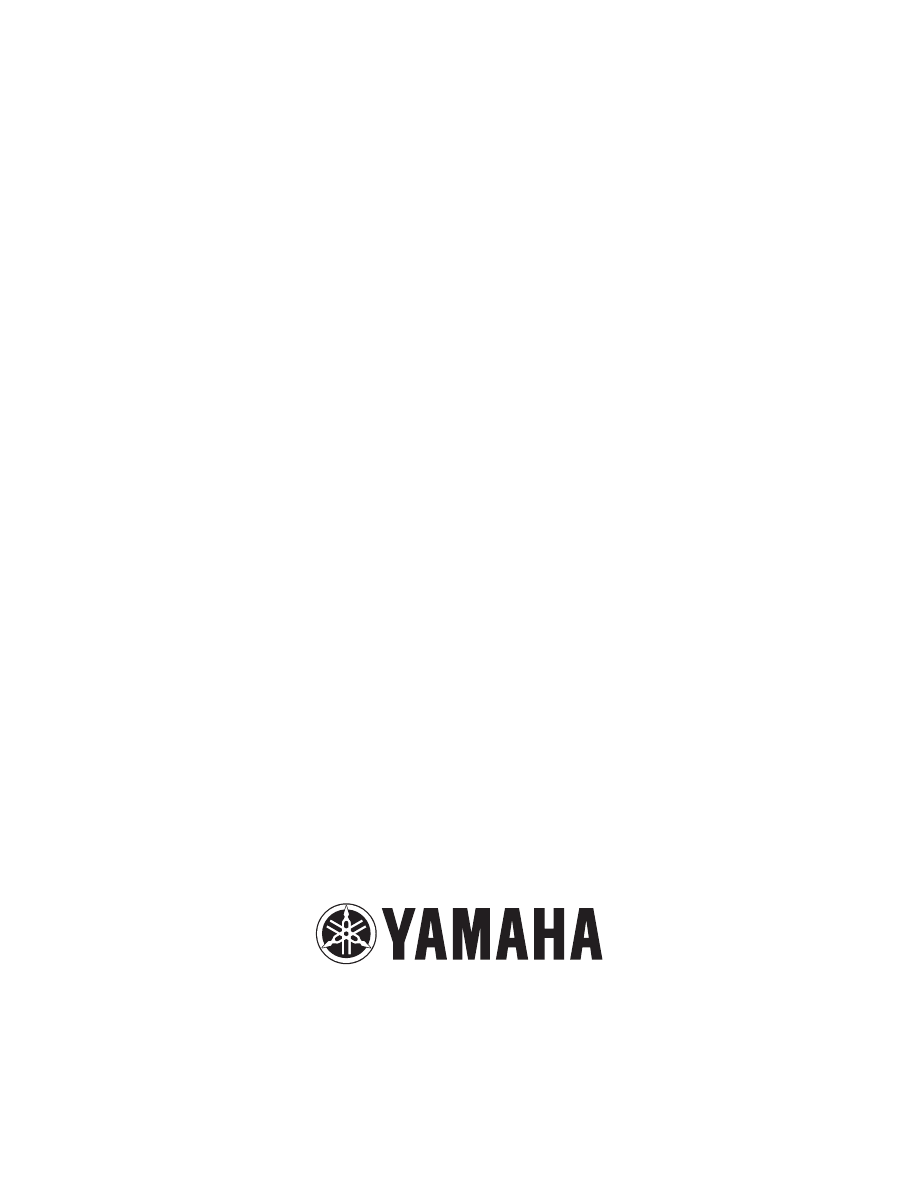
YAMAHA MOTOR CO., LTD.
2500 SHINGAI IWATA SHIZUOKA JAPAN
PRINTED IN U.S.A.
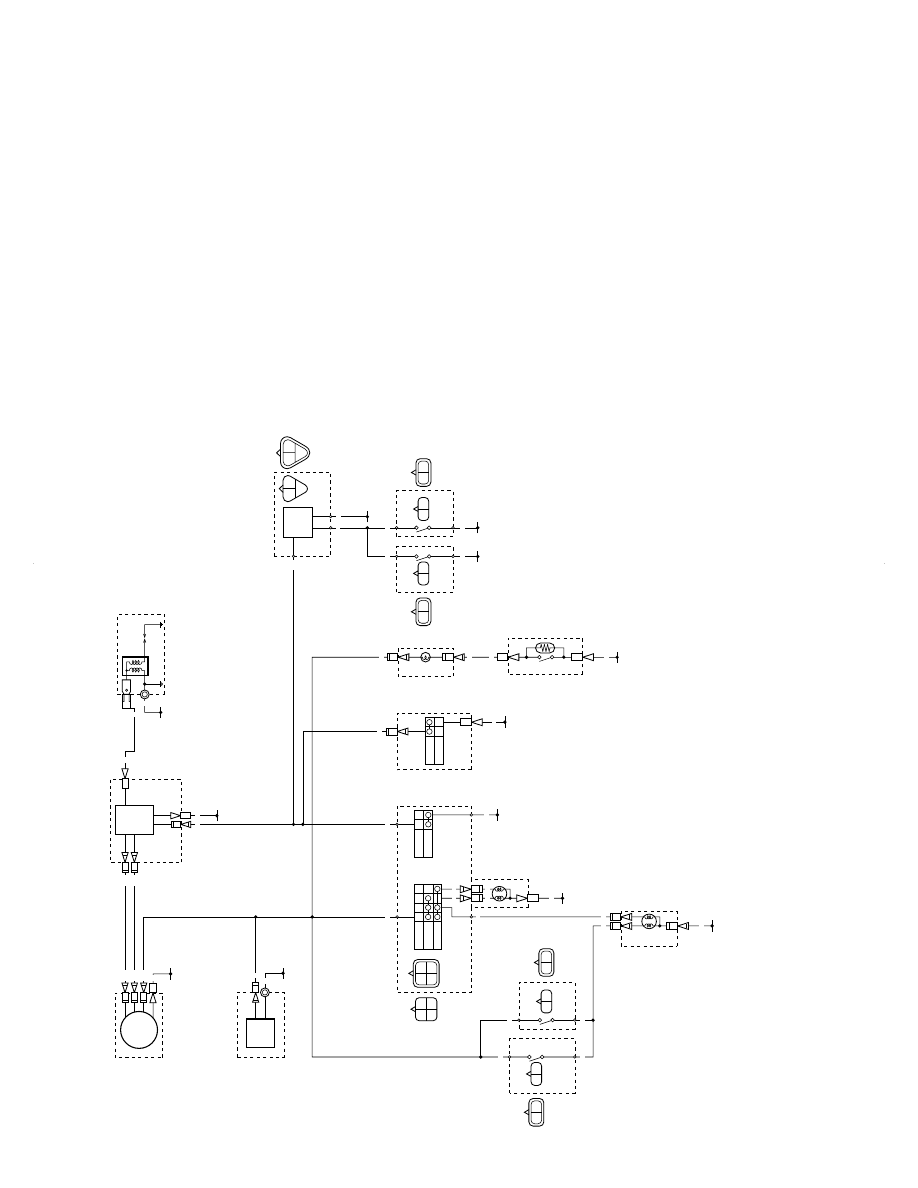
YFS200P WIRING DIAGRAM
B
B
Y
/R
B
/R
W
/R
B
/R
B
/W
B
/W
W
/R
OFF
LO
HI
Y
/R
RU
N
OFF
B
/W
BB
/W
Y
/RL
B
/WB
LY
/R
B
/WY
/B
B
Y
/BB
/W
B
Br
Y
Br
Y
O
B
4
5
B
B
OFF
ON
B
/W
B
B
B
O
B
G
Y
G
Y
L
D
F
CB
A
G
B
Y
L
L
E
YB
r
(BLA
CK)
BB
Br
Y
BB
Y
/B
8
6
BY
/B
Y
/BB
(BLA
CK)
(GRA
Y)
(GRA
Y)
B
B
Y
/B
Y
/B
7
BY
/B
Y
/BB
(BLA
CK)
(BLA
CK)
Br
9
G
0
2
3
1
1
CDI magneto
2
Vo
lta
ge regu
lator
3
CDI unit
4
Ignit
ion coil
5
Spark plug
6
Control unit
7
Throttle switch
8
Carbur
et
or
sw
itch
9
Oil indicator light
0
Oil level gauge
A
Main sw
itch
B
Engine stop switch
C
Lights switch
D
Headlight
E
Tail/brake light
F
Rear brake light
switch
G
Front brake light
switch
COLOR CODE
B
....
...
...
..
Blac
k
Br
...
...
...
..
Bro
wn
G
....
...
...
..
Gr
ee
n
L
..
...
...
...
..
Blue
O
....
...
...
..
Or
an
g
e
Y
....
...
...
..
Y
e
llo
w
B/R
...
....
.
B
lac
k/R
e
d
B/W
..
....
.
B
lac
k/W
hit
e
W/
R
..
....
.
W
hite/
Red
Y/B
...
....
.
Y
ello
w/
Blac
k
Y/R
...
....
.
Y
ello
w/
Red
Wyszukiwarka
Podobne podstrony:
hplj 5p 6p service manual vhnlwmi5rxab6ao6bivsrdhllvztpnnomgxi2ma vhnlwmi5rxab6ao6bivsrdhllvztpnnomg
Oberheim Prommer Service Manual
Korg SQ 10 Service Manual
MAC1500 service manual
Kyocera Universal Feeder UF 1 Service Manual
Proview RA783 LCD Service Manual
indesit witp82euy Service Manual
Glow Worm installation and service manual Hideaway 70CF UIS
Proview PZ456 LCD Service Manual
Glow Worm installation and service manual Ultimate 50CF UIS
ewm2000 service manual
Glow Worm installation and service manual Ultimate 60CF UIS
Proview SH770I LCD Service Manual
M23 Service Manual
Glow Worm installation and service manual Glow micron 60
Konica Minolta QMS 7115, 7118 Service Manual
Honda NSR125 '87 Service Manual
Epson Stylus Color 460 Service Manual
więcej podobnych podstron